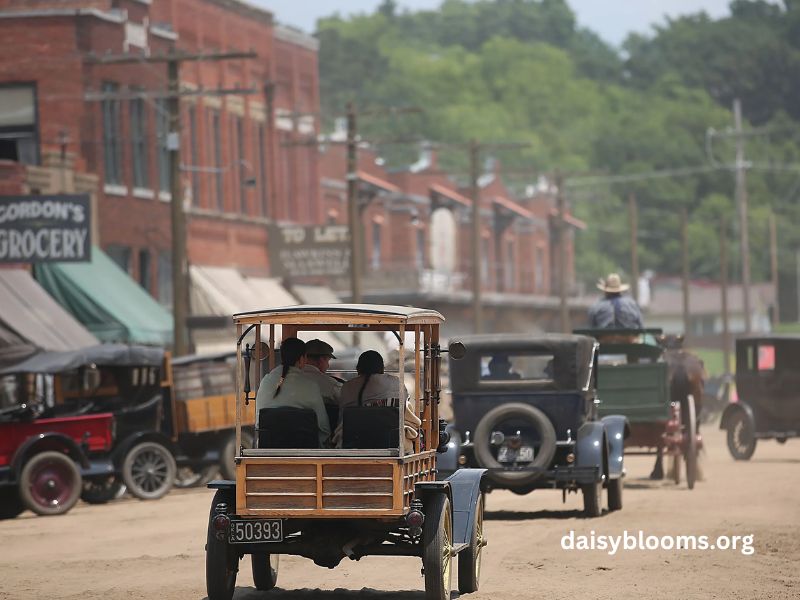Martin Scorsese’s Killers of the Flower Moon is not just a cinematic masterpiece—it’s a vivid portrayal of an important chapter in American history. Beyond its gripping narrative and stellar cast, the film is set against breathtaking, authentic backdrops that transport viewers straight to the early 20th-century Osage Nation in Oklahoma.
Wondering where Killers of the Flower Moon was filmed? You’re in the right place. This blog takes you through the stunning locations that brought this historical drama to life and highlights the incredible attention to detail that makes the movie so immersive.
Why the Filming Locations Matter
At its core, Killers of the Flower Moon tells the true story of the Osage murders—a dark period in American history when members of the Osage Nation, who had become wealthy from oil on their land, were systematically killed in the 1920s.
Scorsese and his team worked closely with the Osage Nation to ensure the historical and cultural accuracy of the film, a decision that extended to their choice of locations. Rather than relying on large studio sets, the filmmakers immersed themselves in the heart of Osage County, Oklahoma, to capture the spirit and authenticity of the story.
Now, we’ll walk you through some of the key filming spots that added authenticity and depth to this poignant narrative.
Pawhuska, Oklahoma – The Heart of the Action
Preserving History in Pawhuska
The majority of the film was shot in Pawhuska, Oklahoma, a small town in Osage County that still retains much of its early 20th-century charm. Scorsese chose Pawhuska as the primary filming location because it closely resembles what the town of Fairfax—the story’s central setting—looked like in the 1920s.
To bring this era to life, the filmmakers transformed Pawhuska by restoring its historic buildings, adding vintage storefronts, and lining its streets with vintage automobiles. Walking through the set was reportedly like stepping back in time!
The Fairfax Square Replica
Though Pawhuska stood in for Fairfax, the filmmakers ensured every detail fit the real-life setting. The team painstakingly reconstructed Fairfax’s brick-paved town square—complete with a functioning train. From the architecture to the layout, every element mirrors the 1920s Fairfax, creating a hauntingly accurate portrayal of the period.
Bartlesville, Oklahoma – Headquarters for the Oil Boom
Another significant filming location was Bartlesville, a charming small city about 45 minutes northeast of Pawhuska. Known historically as one of the key hubs of the early 20th-century oil boom, Bartlesville’s architecture and scenery reflect the wealth and sophistication of the time.
Notably, Bartlesville served as a backdrop for several indoor scenes, showcasing the interiors of mansions and offices of those involved in the oil trade. These scenes juxtapose the lavish lifestyle enjoyed by the oil tycoons with the stark oppression faced by the Osage people.
The Osage Nation Reservation – A Tribute to Community
Collaborating with the Osage Nation
One of the most unique aspects of Killers of the Flower Moon is how the production team worked directly with members of the Osage Nation to respectfully depict their culture and history. Many exterior shots were filmed on the Osage Reservation itself. This decision gave the film an undeniable authenticity and offered viewers an intimate look at modern-day Osage landscapes.
Showcasing Stark Contrast
The filming on the Osage Nation Reservation also highlights the contrast between the natural beauty of the Oklahoma prairies and the darkness of the events that unfolded there. Lush fields stretch endlessly toward big, open skies—a world of serenity altered by greed and violence.
Tulsa, Oklahoma – A Glimpse of Glamour
While Pawhuska and Bartlesville served as the primary locations, select scenes were filmed in Tulsa, further south. Tulsa, with its well-preserved Art Deco architecture, represented the hub of wealth and luxury in the 1920s.
Scenes depicting the high-society lifestyles of certain characters found their perfect backdrop in Tulsa’s ornate mansions and lavish historical buildings. Tulsa lent an air of opulence and contrast to the film’s darker themes.
Why These Locations Are Essential to the Story
The decision to film on location in Oklahoma, rather than relying heavily on CGI or studio sets, underscores the film’s commitment to telling the Osage story with care and authenticity.
By situating the cast and crew in these real-life locations, the filmmakers were able to tie their work directly to the land and culture so central to the story. The Town Square, the Osage prairies, the oil boom landmarks—each location tells its own part of the narrative, contributing to the emotional weight of the story.
Plan Your Own Tour of Killers of the Flower Moon Locations
For film enthusiasts and history buffs alike, the filming locations of Killers of the Flower Moon offer more than just beautiful sceneries—they provide a chance to connect with an important piece of American history. If you’re inspired to visit, here’s how to start planning the ultimate Killers of the Flower Moon trip through Osage County, Oklahoma:
- Pawhuska: Visit the charming downtown area restored for the film, including its iconic brick-paved streets. Don’t miss the Osage Nation Museum for a deeper understanding of this history.
- Bartlesville: Explore its historic buildings and learn about the legacy of the oil boom at the Phillips Petroleum Company Museum.
- Tulsa: Discover the city’s stunning Art Deco architecture and enjoy the luxurious atmosphere captured in the movie.
Bringing History to the Screen
The magic of Killers of the Flower Moon lies not just in its storytelling, but in the commitment to grounding fiction in reality. By filming in locations that resonate deeply with the subject matter, Martin Scorsese and his production team created an extraordinary viewing experience that’s both visually stunning and emotionally impactful.
For those who haven’t yet watched the film, add it to your must-see list—not only for its gripping story and powerful performances but for the breathtaking locations that immerse you completely in the history of the Osage Nation.


